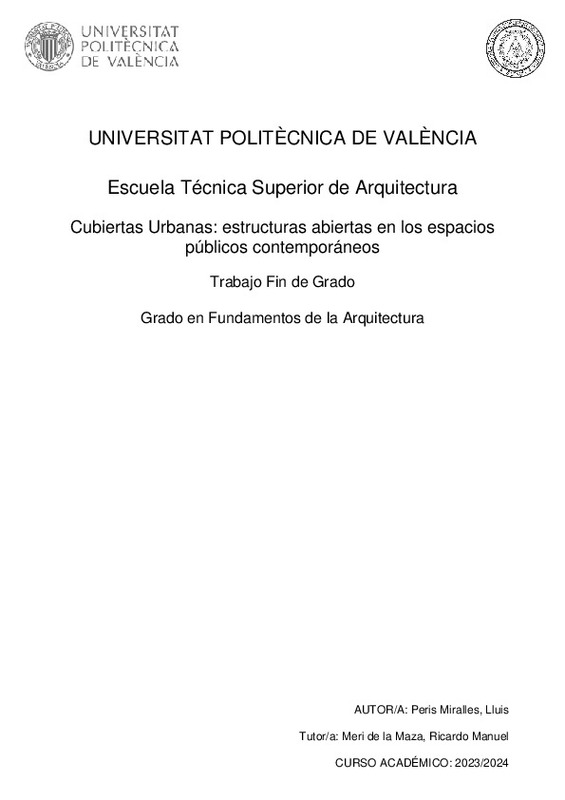|
Resumen:
|
[ES] Los espacios cubiertos públicos contemporáneos son áreas exteriores parcial o totalmente cubiertas que están diseñadas y construidas con el propósito de ser utilizadas por el público en general. Estos espacios pueden ...[+]
[ES] Los espacios cubiertos públicos contemporáneos son áreas exteriores parcial o totalmente cubiertas que están diseñadas y construidas con el propósito de ser utilizadas por el público en general. Estos espacios pueden encontrarse en los accesos de algunos edificios públicos, en museos, plazas, mercados, espacios feriales y otros espacios públicos urbanos. Cuentan con elementos arquitectónicos capaces de proteger de las condiciones climáticas, lo que permite utilizarlos durante todo el año.
Este trabajo pretende investigar brevemente la historia de estos espacios durante el siglo XX, poniendo mayor foco en la postmodernidad y, sobre todo, en los proyectos contemporáneos desde los años 90 hasta el momento actual.
Se analizarán las estructuras y cubiertas como elementos caracterizadores del espacio público, capaces de soportar grandes cargas, resistir el paso del tiempo y las condiciones ambientales; importantes también en la definición de las características estéticas del espacio. Los avances en la tecnología y en los materiales de construcción han permitido que los arquitectos y diseñadores creen estructuras más complejas, lo que a su vez ha ampliado de forma innovadora sus posibilidades de diseño.
Estos espacios son importantes para las comunidades, ya que proporcionan un lugar para que las personas se reúnan, socialicen, aprendan y se diviertan. La incorporación de estos espacios puede ayudar a mejorar la calidad de vida de los residentes, atrayendo además a visitantes interesados en explorar la cultura y la historia de la zona. Además, pueden ser una forma efectiva de revitalizar áreas urbanas y aumentar la convivencia entre las personas.
En conclusión, la finalidad de este trabajo es analizar los distintos espacios cubiertos públicos contemporáneos como parte integral de la vida urbana moderna, proporcionando áreas versátiles y atractivas para el uso público. Estudiar la evolución que han experimentado con los años y sus avances tanto en su tipología y definición estructural como en los materiales empleados.
[-]
[EN] Contemporary public sheltered spaces are partially or fully covered outdoor areas that are designed and built for the purpose of being used by the general public. These spaces can be found at the entrances of some ...[+]
[EN] Contemporary public sheltered spaces are partially or fully covered outdoor areas that are designed and built for the purpose of being used by the general public. These spaces can be found at the entrances of some public buildings, in museums, squares, markets, fairgrounds and other urban public spaces. They have architectural elements capable of protecting from weather conditions, which allows them to be used throughout the year.
This work aims to briefly investigate the history of these spaces during the twentieth century, focusing on postmodernism and, above all, on contemporary projects from the 1990s to the present.
Structures and roofs will be analyzed as characterizing elements of public space, capable of supporting heavy loads, resisting the passage of time and environmental conditions; also important in defining the aesthetic characteristics of the space. Advances in technology and construction materials have allowed architects and designers to create more complex structures, which in turn have innovatively expanded their design possibilities.
These spaces are important to communities as they provide a place for people to gather, socialize, learn and have fun. Incorporating these spaces can help improve the quality of life for residents, while also attracting visitors interested in exploring the culture and history of the area. In addition, they can be an effective way to revitalize urban areas and increase coexistence among people.
In conclusion, the purpose of this work is to analyze the various contemporary public covered spaces as an integral part of modern urban life, providing versatile and attractive areas for public use. To study the evolution they have undergone over the years and their progress both in their typology and structural definition as well as in the materials used.
[-]
|







